 WHERE TO GO... WHERE TO GO... |
 Colombo Colombo |
Situated on the West coast, it is by far the most cosmopolitan and also the biggest city in the country. For centuries the natural harbour attracted traders and conquerors. It is a colourful city that thrives during the day with busy street markets, buildings from colonial times, churches, mosques and temples. Its centre is the Fort area, built by the Portuguese to defend the city from invasions.
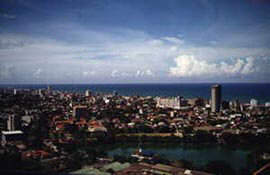
The Fort was taken over by the Dutch, and later on completely destructed by the British. It is the city’s commercial and business centre, housing all major hotels and company offices. The most prominent landmark in the Fort is its lighthouse, but you will also find the President’s house - yet this site is off limits to visitors.
 Pettah Pettah |
East of Fort separating the outer harbour from the Beira Lake, there is a bunch of streets and alleys crammed with food, textiles, gold and antiques and anything imaginable. Anything and everything that you might be looking for, you will find it here. Some of the most interesting streets are Sea Street where you find the gold smiths and the colourful Hindu Kathiresan and old Kathiresan temples. Nearby you find the Grand Mosque, which is the most important Mosque for Sri Lankan Muslims. The Mosque is situated on new Moor Street; another impressive Mosque is the Jami Ul Alfar Mosque, which you will find at the corner of Bankshall Street and Second Cross Street.
 The other places around Colombo The other places around Colombo |
Another interesting thing to see in Colombo is the Dutch period museum. It was build in the second half of the 17th century and was the residence of count August van Ranzow, the Dutch East India Company Governor in Colombo. The address is 95, Prince Street, Colombo 01. Another relic of the Dutch period is the Wolvendaal Church, built in 1749 it is the stone church situated on Wolvendaal Street. The most interesting thing at this site is the Tombstone set to the floor of several Dutch Governors.
Other interesting sites around Colombo include Slave Island, Cinnamon Gardens with the statue of Queen Victoria and the Town hall along with the golden image of Buddha. There is also the National Museum, Natural History Museum, Children Museum, and BMICH.
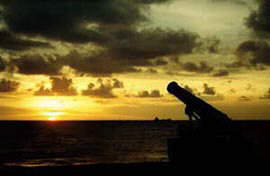
If you want to go to the beach while in Colombo you can visit Negombo, which is only 37 kilometres away from Colombo’s city centre. Negombo surrounds a lagoon very rich in fish; today, the town mainly relies on tourism. The most picturesque sight in Negombo is its twin hulled sailing canoes. Here you can also visit the Dutch Fort, which dates back to 1678, as well as St Mary’s church that has an impressive ceiling worth looking at.
Mt Lavinia, about 11 kilometres away from Colombo, hosts the Mount Lavinia hotel, residence of the British Governor Sir Thomas Maitland. The hotel retains its old colonial ambiance and has a great pool with fantastic views of Mount Lavinia Beach.
 Hill country and Kandy Hill country and Kandy |
Kandy is the hearth of Sri Lanka. For a long time, it was the true capital of the Kandy Kingdom and the last strong hold of the Singhalese kings. Kandy is about 115 km from Colombo but the journey can take up to three hours; the best way to reach Kandy is by train, the scenery is beautiful and there is air conditioned wagons.
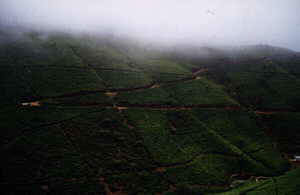
The best things to see around Kandy are the Temple of the Tooth, which is a major pilgrimage site for Buddhist and hosts a relic tooth of the Buddha. About 6 km from Kandy’s downtown, you can find the Royal Botanical gardens laid out by King Kirthi Sri Rajasingha between 1747 and 1780; the gardens cover an area of about 150 acres and has an enormous quantity of rare tropical trees and plants plus a beautiful exhibition of orchids.
 Embeke Devale Embeke Devale |
About 18 km from Kandy, there is a small Buddhist temple, the Embeke Devale, dating to the 14th century; it is open during the day and is worth taking a look at.
Sri Lanka is filled with ancient temples and sacred sites; some of the temples available around the Kandy area are the Gadaldeniye Temple and the Lankatilake Temple. Near Kandy you also find the Pinnewala elephant Orphanage, about 20 km from the city centre. Young orphan or abandoned elephants are taken here, but if you do not like to see animals in captivity perhaps you should avoid visiting this place. You can see herds of up to 50 elephants of all sizes. Best time to visit is between ten to midday, and in the afternoon hours when you can see the elephants bathe.
 Nuwara Eliya Nuwara Eliya |
This place is where you find most of the Tea plantations of the country. It is situated 100 km South of Kandy, and it is one of Sri Lanka’s most verdant hillsides. There is much reminiscence of British colonialism. Nuwara Eliya was built during the 19th century and its architecture is typical of an English country town, with red brick walls and mocks Tudor half timbering. Sri Lankans still visit the area for its cool climate and fantastic views of the tea plantations.
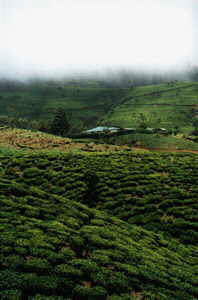
 Pidurutalagala Pidurutalagala |
Sri Lanka’s highest peak also known as Mount Pedro is about 2524 meters high. Going up to the top of the mountain is restricted due to security reasons - the central television transmitter of the island being located there. If you want to enjoy the views you can walk to the top through the Single Tree Mountain; the hike takes about 90 minutes.
 Horton National Park Horton National Park |
20 km south of Nuwara Eliya you find a high plateau with amazing misty views and great scenery all around. Here you also find a number of high peaks such as Kirigalpotta and Totapola both at over 2300 meters above sea level. There is wild life to be seen like the samabar, the bear onkey, and the giant squirrel and if lucky leopards. There is also a great abyss that many tourists enjoy visiting named Worlds end, with a fall of 700 meters.
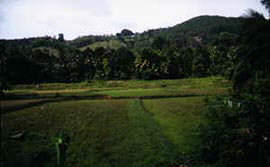
 Peak Wilderness Sanctuary and Adams Peak Peak Wilderness Sanctuary and Adams Peak |
Bordering Horton plains there is Peak Wilderness Sanctuary, in the middle of the reserve you find Adams Peak, a sacred place to all religions in Sri Lanka. Muslims and Christians believe that Adam first set foot on its top after he was thrown out of the Garden of Eden. Other Christians believe that the footprint found on top of the mountain is that of St Thomas who introduced Christianity to India and the Island in the first century AD. Hindus on the other hand believe that the mark belongs to that of the Lord Shiva. Buddhists also have their own theory on the nature of the footmark, believing that it is the foot of the Buddha on his third visit to Sri Lanka. During the months of December thru April, thousands of pilgrims trek up the peak. Climbing to the top can take up to eight hours but it is if you climb from Dalhouise village the ascent can be shorten to four hours.
 Ratnapura Ratnapura |

River Miner at Ratnapura
About 100 km from Colombo there is the capital of Sri Lanka's gems. Ratnapura has wonderful views of Adams peak on the east and is surrounded by hills covered with a large quantity of trees. Gems are dug in either small mines or in the near by rivers. Extreme caution must be used when purchasing gems from dodgy individuals or shops. Gems are still mined for in the old traditional ways by searching through the gravel of the near by streams and rivers. There are also open pit mines that might vary in depth and size. They are usually a cooperative effort in which all the members of the search take part in the work as well as the profits. Sri Lanka also has the peculiarity that you find several kinds of different gems within the same pit. There is very little that distinguishes a precious stone from a semi precious one; it is merely a categorization matter.
Gems are divided into the following categories.
Corundrums: They include sapphires and rubies, both considered precious stones, the only other gem to be stronger than them is the diamond
Chrysorberyl: These include cats eye and Alexandrite. Cats eye’s colour can range from green to yellow. Alexandrite has the peculiarity of changing colours in different lights
Zircon: The appearance of this stone is quite similar to that of the diamond. Colour ranges from yellow to orange to brown and even green.
Quartz: The colours of quartz can range from dark black to clear white to purple amethyst
Feldspar: Called moonstone in Sri Lanka it is one of the most characteristic gems of Sri Lanka.
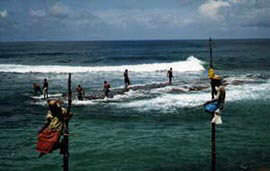
 Southwest Southwest |
The southwest part of the Island is the touristiest area. Though this is one of the most developed tourism areas in the country, there is still much coastline that remains almost intact. This is also a great location for diving and snorkelling as there is large quantity of coral and marine wildlife. Galle is the largest town in the region and hosts a Fort built by the Dutch that is almost intact to this day. Surfing is especially popular in the town of Hikkaduwa where during the winter season many surfers from all around the world gather to catch some impressive waves.
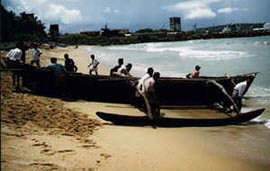
 Beruwala Beruwala |
Almost 60 km south of Colombo there is the town of Beruwala; here you find the largest concentration of beach resorts in the whole southwest. There is a wide range of medium to luxury hotels; there are also a good number of restaurants as well as wonderful sandy beaches. One of the most interesting sites around is the Kechimalai Mosque built by the first Muslim traders that visited the Island.
Further South you can visit the Kosgoda Turtle Hatchery, which incubates and releases thousands of green and leatherback turtles into the wild to protect them from predators. You will also find the town of Ambalangoda where you can buy locally crafted masks and puppets. Also worth visiting in Ambalangoda is the mark Museum, situated north of the village centre; it displays masks symbolizing the demons, heroes, gods and bad guys that appear in processions and traditional dances.
 Hikkaduwa Hikkaduwa |
Hikkaduwa stretches along the seaside for about 5 km. You can find accommodations fitting almost every budget. It is also a great location to see coral reefs whether by snorkelling or by taking a clear bottom boat. During the high season Hikkaduwa becomes a major surfing spot. Near, about 2 km inland you can also visit the Tewatta Bird Sanctuary.
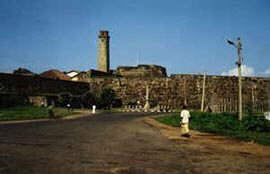
 Galle Galle |
About 116 Km from Colombo, Galle is the second largest city in the Island. Once the most important port in Sri Lanka, its fort was built by the Dutch in the mid 17th century
It has acquired the “World Heritage” status as one of the best colonial cities in South East Asia.
Some interesting sites around Galle are the New Oriental Hotel, built in 1648; it was originally the official residence of the Dutch Governor; it is considered as Sri Lanka’s oldest and most authentic colonial era hotel. Another interesting landmark is the “Groote Kerk” or Great Church, built in 1640. Other attractions include the Dutch museum and the National Maritime museum.
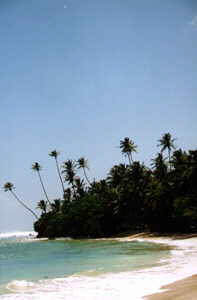
 Unawatuna Unawatuna |
About 5 km South of Galle, you will find some of the best beaches in the world. Big scale tourism projects have still to reach this area; though frequented by back packers and divers, the area is quite underdeveloped. It has a well-preserved coral reef, a good number of marine wild life and even some ship wrecks about 2 to 3 miles from the beach’s shore.
Weligama town situated about 30 km from Galle offers the opportunity to witness its unique stilt fishermen. The fishermen of this town use a unique method of fishing, they stand on sturdy poles 50 to 80 meters out to sea. The poles are passed on from generation to generation |  Sinharaja Biosphere Reserve Sinharaja Biosphere Reserve |
One of the most important bio-diverse sites within Sri Lanka, Sinharaja reserve offers to the visitor the opportunity to witness the beauty and richness of Sri Lanka’ s diverse fauna and flora. Within the reserve you can see endemic bird species such as the Lanka spur fowl, the hanging parrot, or the grey hornbill. Other animals that can be seen within the reserve are the giant squirrel, the purple faced leaf monkey and if you are lucky perhaps some leopard.
 THE SOUTHERN COAST THE SOUTHERN COAST |
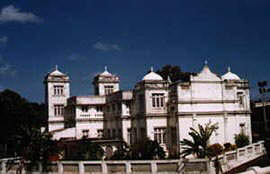
 Matara Matara |
Matara is a relatively large city to Sri Lankan standards. At one time the city and its port were one of the most important trading spots of spices and gems with the Middle East. The oldest part of Town is the one situated on a little peninsula separated from the Island’s mainland by the Nilwala Ganga River. The Dutch who also built a fort around it, which stands to this day, also occupied this. Within the fort you will find a good number of old colonial buildings of Dutch style.
 Wewurukannala Temple Wewurukannala Temple |
This temple was built onto an old building, and it hosts the world’s largest Buddha image, though there are many other temples that claim to have the largest Buddha image as well. The Image is built on reinforced concrete; it is accessible from the inside where you can leave a donation for the temple and look at the surrounding countryside.
 Uda Walawe National Park Uda Walawe National Park |
This Park contains a wide variety of terrain from abandoned tea plantations to scrub jungle. There is also an artificially made lake on the middle of the park called the tank that is used for irrigation and production of hydropower.
Uda Walawe Park was originally established as a reserve for migrating elephants. Yet, the park is a sanctuary for many mammals like the toque monkey, the grey langur the spotted deer, wild pig leopard and sambar. There is over a hundred bird species. The most interesting animals to look ate are the reptiles eating birds’ such as the crested serpent eagle and the changeable hawk eagle.
 Bundala National Park Bundala National Park |
The habitat of this Park is dominated by scrub jungle. There is a large number of swallow ponds where many migratory birds are attracted. The leather back and olive riddle turtle uses the near by beaches to lay their eggs, and from time to time it is possible to see hawksbill and green turtles as well. There are also other reptiles like crocodiles. Mammals within the park include wild elephant, spotted deer, grey langur and many others. Although a small park the concentration of wildlife is impressive.
 Great and Little Bases Great and Little Bases |
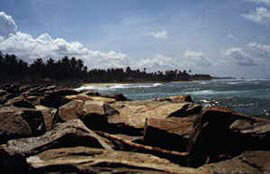
If you are a diver, Sri Lanka offers some of the best diving spots in the world due to its impressive coral reef and abundant marine wildlife. The best location for diving is in the great bases, about 30 km from Bundala National Park. The currents being quite strong, it is advisable that only very experienced divers go to these waters.
This area has also been declared a high-risk area because of the presence of guerrillas and the zone remains a no go area to this day though locals claim that it is safe for foreigners to visit.
 Kataragama Kataragama |
Kataragama is Sri Lanka’s second most sacred place. The town has a shrine, which is located on the sands of the Menik Ganga or river of jewels. Many Buddhist consider the surrounding forest as a sacred place where Buddha planted a bo tree. Hindus on the other hand claim that this sacred place is where the god of war Skanda lives.
The pilgrimage to the site includes bathing on the waters of the sacred Menik Ganga and throwing a coconut in hope that it will break open as a sign of good luck and prosperity.
The temple is believed to be amongst the most ancient in Sri Lanka dating back to the second century BC .The temple of Kataragama has several Buddhist and Hindu shrines out of which the Maha Devala stands as the most important one. Other Hindu gods within the shrine include Vishnu, and the elephant headed Ganesh.
In Kataragama you can also witness the Thaipusam Festival. This Tamil festival is known for its extreme rituals during which devotes drive skewers through their cheeks and tongues; other practices involve the hauling of deities attached to their back and shoulders by steel hooks.
 Ruhuna National Park Ruhuna National Park |
This Park is one of Sri Lanka’s most popular national parks. The park covers an area of 100 square km and the habitat is mainly made up of scrub jungle, open savannah and riverine woodland as well as a long stretch of coastline on the south west of the Island. Ruhuna is the best park to see the mammal species of Sri Lanka. Though its size is quite big only part of it is accessible to visitors. Spotting the animals can be difficult at times due to the nature of the terrain. Yet you will be able to spot leopards, game and large numbers of elephants.
 Anuradhapura and Polonnaruwa Anuradhapura and Polonnaruwa |
The northwest part of the Island is also known as the Cultural triangle. The region has some of Sri Lanka’s most well known sites; temples and large shrines can be spotted all through the region. The most relevant sites are Sigiriya - an incredible rock pinnacle that hosted an impressive royal palace on its top - and Anuradhapura and Polonnaruwa, once the capitals of very advanced civilizations that relied on complex irrigation networks.
 Dambulla Dambulla |
Dambulla has one of Sri Lanka’s most breath taking cave temples. Dating back to the first century before Christ, this temple is composed of five different caves where there are numerous images of sitting, standing and reclining Buddhas as well as images of Hindu gods. All the caves are decorated with scenes of Buddha’s life. The murals are not as ancient as the carvings. The temple is said to have been built by King Valagam Bahu who was defeated by the Indian kings. The temple is open daily from 600 am to 700 pm.
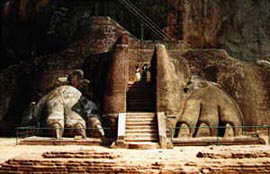
 Sigiriya Sigiriya |
Sigiriya is an impressive rock pinnacle that was fortified during the 5th century AD. An ancient palace with royal gardens and swimming pools included topples the rock
The palace complex was built between 473 and 480 A.D. by king Kasyapa. Midway up the stairway that leads to the top there are the Sigiriya Damsels, wall paintings of the kings 500 concubines; out of these only 22 survive to this day. Further up the stairs you find the Mirrors wall, which has graffiti dating back to the 8th, which has given today’s linguistic researches many leads into the origins of the Sinhala language. The end of the stairs leads into the door to the palace, which is presided by two enormous lion paws. There is very little left of the palace except the original foundations of the building and the rock throne in which king and queen will preside the court meetings.
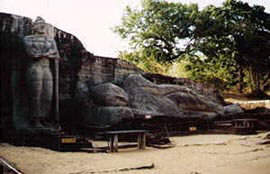
 Polonnaruwa Polonnaruwa |
Polonnaruwa is one of the two most impressive capitals of Sri Lanka’s most ancient and powerful kingdom. Polonnaruwa is the smallest of the two cities and also the most modern one. Polonnaruwa was in fact the second capital of the kingdom; the capital was moved from Aradnahapura because of its strategic location. Albeit massively fortified, the city was eventually defeated, its kings and inhabitants were forced to leave the capital.
The ruins of the city stand on the East Shore of the Topa Wewa Lake, an artificial lake built by the Sinhala king Parakramabahu I, who ruled over Polonnaruwa during its golden age. Amongst the palace’s ruins there is plenty of royal gardens dagobas and many other buildings that were once part of the great city of Polonnaruwa.
There are also a big number of other historic buildings on the north part of the city complex; many relics that have been excavated from the sites can be seen at the National Museum in Colombo.
For more archaeological sites near Polonnaruwa, you can also visit the Medirigiriya Vihara temple. Built in 1300 A.D. the temple is very similar in its architectural characteristics to the Vatadage temple of Polonnaruwa with concentric rings and Buddhas seated to the north south east and west of the temple. Further to the west, at about 15 miles from Polonnaruwa is Ritigala, a not very well known archaeological site in spite of its richness. Its Forest Monastery offers incredible views of the surrounding country and woodlands. Furthermore, you can climb up the Mihintale rock, an old sanctuary that dates back to 250 BC. It is said that monks have built the hospice below over 2200 years ago plus 60 to 70 caves used for meditation.
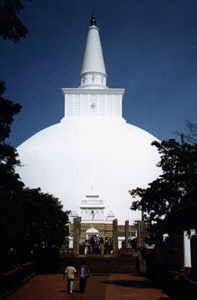
 Anuradhapura Anuradhapura |
Anuradhapura is the oldest and largest city from the era of Sri Lanka’s great empires. King Pandukhabaya founded the city in the year 437 BC. The city quickly acquired fame all over the ancient world; there is evidence of the active trade that existed between the east and the west with Anuradhapura and the Sinhala kingdom. The city was a major centre for the traders and successful businessmen of the time. It maintained its capital status for over 1400 years. Its proximity to India made it vulnerable to its attacks but also enriched the city and the whole empire along with it. The constant attacks of the neighbouring Tamil kings of Southern India finally forced the capital to settle in Polonnaruwa.
Within the Anuradhapura complex the most interesting sites is the Sri Maha Bodhi or sacred Bo tree. It is said to be the oldest tree in the world and the first specimen to have been brought by the Buddhist emperor Ashok in the 3rd century BC. The tree stands in the cross roads of Sri Maha Bodi Mihindu Road and Kurunegala Road.
Along with it, there is the Loha Prasada, a vast building that once stood next to the sacred Bo tree and that had more than 1600 pillars that rose more than nine storeys.
One of the most impressive dagobas in the complex is the Runaweli Seya Dagoba. Over 50 meters high it is said to have been much taller originally. Also within the complex there is the Royal Palace. The palace’s ruins date to the 12th century AC; it was constructed during the reign of king Vijayabahu who built it in an effort to give the city the glory and splendour that it once had.
Other interesting sites nearby are the Jetavanarama Dagoba and Museum. This Dagoba is 122 meters high with a base of about 113m; it is one of the biggest Buddhist buildings in Southern Asia. Also worth seeing is the Gem palace, the Abhayagiri Dagoba, the Kuttan Pokuna or twin ponds used by the monks that resided in the palace. Also do not miss the Royal Pleasure gardens built around ponds and rocks.
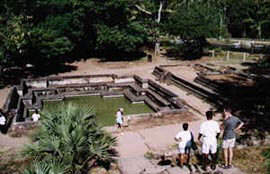
 Trincomalee, North and East Coast Trincomalee, North and East Coast |
The north and east parts of Sri Lanka are the most virgin and authentic parts of the Island. This is due to the fact that when the tourism boom hit the island, these areas where more out of reach than the south and western shores. In addition to this the ongoing ethnic conflict has had a devastating effect on the flow of tourists to this area, not to mention the lack of infrastructure that prevails in most of the East regions and particularly in the Jaffna area.
 Trincomalee Trincomalee |
The east coast monsoon is during the months of October to January; the maximum temperatures in the region are 35degress Celsius from April to September but it drops to below 30 degrees during rest of the year with an average temperature between 26 to 30 degrees.
Trincomalee is the region’s largest city sitting in the middle of two bays. It is said to have one of the most precious sightseeing, with the most virgin and incredible beaches. There is a natural harbour that made the city an appealing stopping point for merchants and conquerors alike. For a very long time the Trincomalee’s port was one of the most important ports of the British Empire in Asia.
Built by the Portuguese and refortified by the Dutch and the British, Fort Frederick, is now under the control of the Sri Lankan navy. At the top of the promontory is Swanni rock, where there use to be a Buddhist temple that was demolished by the Portuguese.
Amongst the best beaches, it is worth mentioning Uppuveli only about 6 km away from downtown, and Nilaveli a very long beach about 16 km from Trincomalee’s city centre.
 Batticaloa and Evirons Batticaloa and Evirons |
Batticaloa is the second largest town in the east coast; located on a long sandy body of land it is separated from the main Island by a large lagoon extending south. During the 1980’s the town was the main LTTE stronghold, till 1991 when the Sri Lankan Army sized control of the city. Yet the surrounding countryside is labelled as very dangerous for travellers.
 Arugam Bay Arugam Bay |
This fisherman’s town acquired a reputation for being a surfer’s paradise. Beaches are long and quite deserted; it also has a large lagoon nearby that host many wild bird species worth looking at.
 Lahugala National Park Lahugala National Park |
During the dry season this park is said to have the largest concentration of elephants in the whole of the Island. The park was set up to provide a corridor for migrating elephants that moved from Ruhuna National Park and Gal Oya Park in the North.
 Gal Oya National Park Gal Oya National Park |
This Park is made up of scrub along with a large man made reservoir made from the damming of the Gal Oya River. There is lots of game and elephants to be seen here. The park remains a restricted area for visitors.
 Jaffna and the North Sri Lanka. Jaffna and the North Sri Lanka. |
The North part of the Sri Lanka is not as green and lush as the South and the East. This area is the Tamils heartland having been the epicentre of the war that devastated the country during the 1980’s and 90’s. Apart from the Jaffna Fort there is not very much to be seen in the Jaffna region, except for some of the small islands of Adams Bridge such as Mannar island, or Delf island, which also has a small fort.
|

